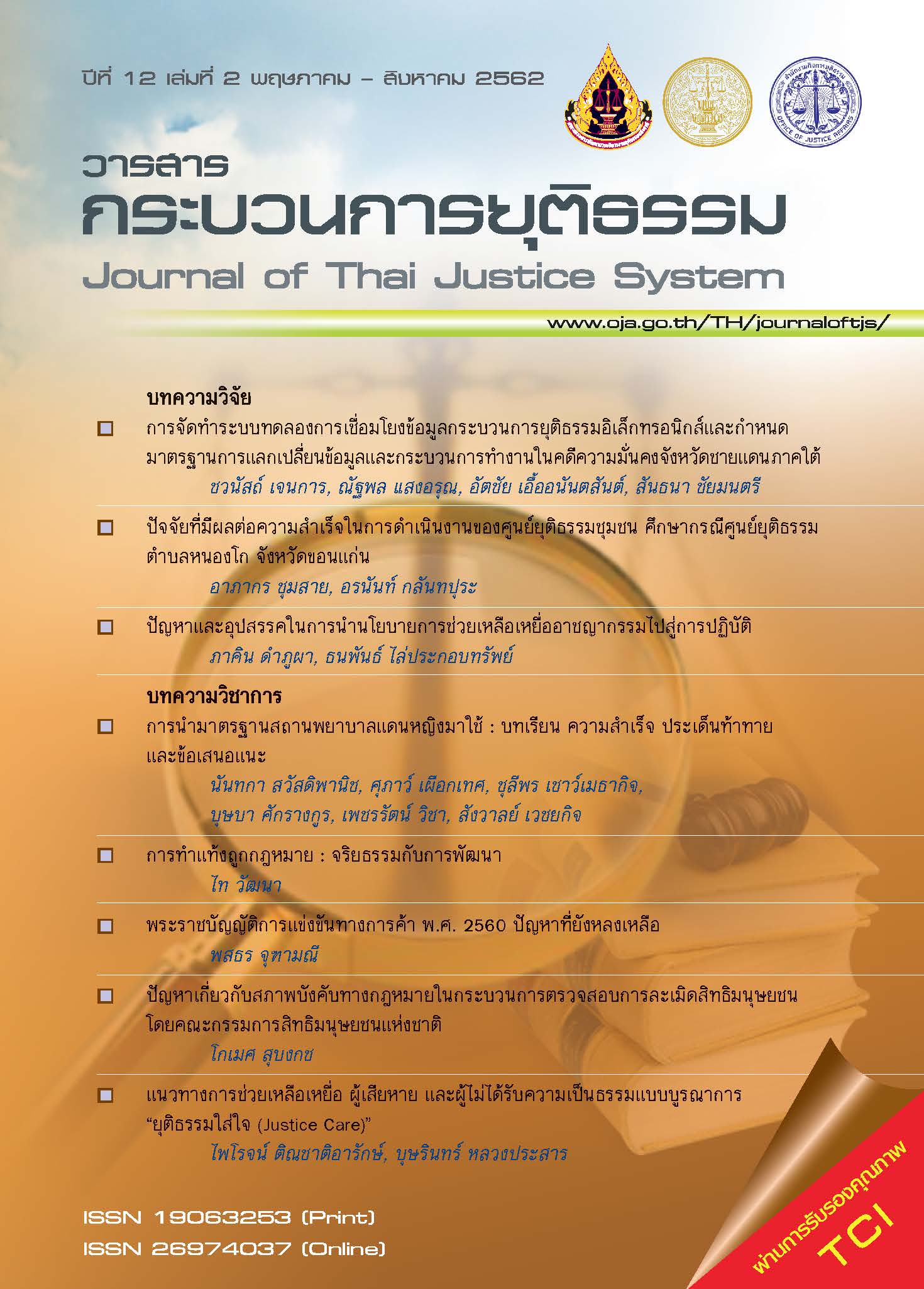Legal Abortion : Ethics and Development
Main Article Content
Abstract
Abortion is one of the public health issues that has been getting attention and has been arguing extensively. Two important aspects of these arguments are ethics and development aspect. On the ethical argument, the restrictive abortion law faces the problem of women rights violation as well as the legal abortion law that face the problem of child rights violation. On the development argument, the restrictive law causes many forms of economic costs, for instance, the healthcare expense for women with illness from unsafe abortion, economic losses from abandoned child’s crime and economic losses from decreasing in the number of skilled labor because of adolescent dropout from school to become a teen mother. In the context of Thailand, that has the restrictive abortion law, adopting the concept of legal abortion are seems to be the right intervention against unsafe abortion and other related problems. Nevertheless, legal abortion also has the economic costs that are the cost of investing and distributing the safe abortion service therefor the government should study and research more about the economic cost and benefit of legal abortion. Moreover, the government should operate public discussion in order to develop optimal abortion policies.
Article Details

This work is licensed under a Creative Commons Attribution-NonCommercial-NoDerivatives 4.0 International License.
Published Manuscripts are the copyright of the Journal of the Justice System. However; the opinions that appeared in the content are the sole responsibility of the author.
References
กิตติพงศ์ แซ่เจ็ง. (2556). สถานการณ์ปัญหาสิทธิอนามัยเจริญพันธุ์.ค้นจาก https://ilaw.or.th/sites/default/files/Slide%20De.Kittipong%20RH%20law%20situation.pdf.
กรมพินิจและคุ้มครองเด็กและเยาวชน. (2556). รายงานสถิติคดี ประจำปี พ.ศ. 2556. กรุงเทพฯ:
ศูนย์เทคโนโลยีสารสนเทศ กรมพินิจและคุ้มครองเด็กและเยาวชน.
กรมพินิจและคุ้มครองเด็กและเยาวชน. (2557). รายงานสถิติคดี ประจำปี พ.ศ. 2557. กรุงเทพฯ:
ศูนย์เทคโนโลยีสารสนเทศ กรมพินิจและคุ้มครองเด็กและเยาวชน.
กฤตยา อาชวนิจกุล และกนกวรรณ ธราวรรณ. (2543). ขบวนการเคลื่อนไหวทางสังคม บนมิติการเมืองเรื่อง
เพศและร่างกายผู้หญิง. การสัมมนาเรื่อง ขบวนการทางสังคม : พลวัตเศรษฐกิจการเมืองไทย พ.ศ. 2543กรุงเทพฯ.
ขวัญใจ เพทายประกายเพชร และ ปวีณภัทร นิธิตันติวัฒน์. (2559). การตั้งครรภ์ไม่พึงประสงค์และการทำแท้ง:
แนวทางป้องกันสำหรับวัยรุ่น. วารสารวิทยาลัยพยาบาลบรมราชชนนี, 32 (2), 133-146.
ไชยยศ เหมะรัชตะ. (2534). ปัญหากฎหมายทำแท้ง แนวทางการแก้ไขปรับปรุง. จุฬาลงกรณ์สาร, 3(10), 71.
ประมวลกฎหมายอาญา ฉบับอ้างอิง. (2550). (พิมพ์ครั้งที่ 18). กรุงเทพฯ: สำนักพิมพ์วิญญูชน
มูลนิธิเพื่อสุขภาพและสิทธิอนามัยการเจริญพันธุ์ของสตรี (แห่งประเทศไทย). (2561). สถิติและสถานการณ์
การแท้งในประเทศไทย., ค้นจาก http://www.womenhealth.or.th/home-facts-aboriton.html
วิลาสินี พนานครทรัพย์. (2554). การทำแท้ง : มุมมองที่แตกต่าง. วารสารสังคมวิทยามานุษยวิทยา,
(1), 92-116.
สำนักอนามัยการเจริญพันธุ์. (2557). สถิติการคลอดของแม่วัยรุ่นประเทศไทย ปี พ.ศ. 2556. นนทบุรี:
สำนักงานกิจการโรงพิมพ์องค์การสงเคราะห์ทหารผ่านศึก ในพระบรมราชูปถัมภ์.
อมรวิชช์ นาครทรรพ. (2557). เด็กด้อยโอกาส จุดพลิกผันอนาคตชาติ. ประชุมวิชาการ‘อภิวัฒน์การเรียนรู้…สู่จุดเปลี่ยนประเทศไทย’. นนทบุรี: มาตา การพิมพ์.
UNICEF. (2558). การวิเคราะห์สถานการณ์การตั้งครรภ์ของวัยรุ่นในประเทศไทย รายงานสังเคราะห์ 2558.
กรุงเทพฯ: องค์การยูนิเซฟประจำประเทศไทย.
หนังสือต่างประเทศ
Dwyer, S., & Feinberg, J. (1997). The problem of abortion. CA: Wadsworth Pub.
Guttmacher Institute and World Health Organization. (2012). Facts on induced abortion worldwide. [n.p.]. [n.d.].
Levitt, S. D., & Dubner, S. J. (2007). Freakonomics. New York: Clipper Large Print.
United Nations. (2014). Abortion Policies and Reproductive Health around the World. [n.p.]. (United Nations publication).


